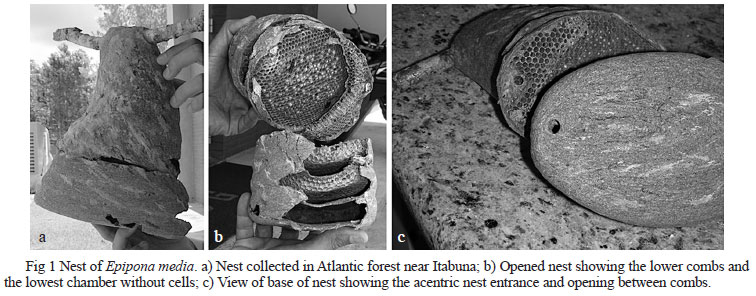Abstract
An occupied nest of Epipona media Cooper was discovered and collected in a cabruca (cocoa plantation with native tree cover). This is the first record of E. media from Bahia State. We described the nest structure and compared the adults with the closely related species Epipona tatua Cuvier.
Nest architecture; geographical distribution; Epipona tatua
SCIENTIFIC NOTE
Epipona media cooper (Hymenoptera: Vespidae), a social wasp new to the Brazilian Atlantic Forest
Rodolpho S T Menezes; Antonio F Carvalho Filho; Anthony Raw; Marco A Costa
Depto de Ciências Biológicas, Univ Estadual de Santa Cruz. Rod Ilhéus/Itabuna km 16, 45650-000 Ilhéus, BA, Brasil
ABSTRACT
An occupied nest of Epipona media Cooper was discovered and collected in a cabruca (cocoa plantation with native tree cover). This is the first record of E. media from Bahia State. We described the nest structure and compared the adults with the closely related species Epipona tatua Cuvier.
Key words: Nest architecture, geographical distribution, Epipona tatua
Epipona is a well-known neotropical genus of social wasps. Its durable nests are bought as souvenirs by tourists. The five known species range from Mexico through Central America and northern South America to Peru and Brazil (Richards 1978). Three species are found in Brazil. Epipona media Cooper was described recently from Ecuador, Peru, Brazilian Amazonia and a lone female collected at Luziânia (16º 15' S and 47º 57' W), Goiás State in central Brazil. One of us (AR) collected a lone female of this species in agallery forest at Fazenda Água Limpa, the field station of the Universidade de Brasília (14º 47' S; 39º 16' W) in May 5th, 1982
An occupied nest of E. media was discovered and collected (by AFCF and RSTM) in 'cabruca' (cocoa plantation with native tree cover). It was attached to a branch c. 10 m from the ground on a flamboyant tree (Delonix regia) on the north side of the Itabuna-Ilhéus highway, c. 8 km east of Itabuna, Bahia State, Brazil (14º 47' S and 39º 16' W).
The general architecture of the nest is typical of the genus (Fig 1). The 0.91 cm diameter single entrance was located at the side of the oval base and the openings of the combs were aligned with the entrance and measured c. 0.59 cm diameter (Fig 1c). The entire nest was 25 cm long. The longer and shorter diameters of the base were 21 cm and 12 cm and of the uppermost diameters were 6.7 cm and 4.8 cm, respectively. The nest contained nine combs with c. 732 cells in the largest (lowest comb) and 165 cells in the smallest (uppermost comb). Cell diameter averaged 0.44 mm. The space between combs ranged from 0.6 cm to 1.42 cm. There were neither cells nor even cell bases on the roof of the lowest chamber between the base of the nest and the floor of the lowest cell chamber (Fig 1b). The outer envelope was not as tough as that of Epipona tatua Cuvier, and on hitting the ground the nest broke between the 7 th and 8 th combs.
Larvae were collected for analysis of their chromosomes and adults stored for future molecular analyses. Larvae were affixed to the base of the cell so strongly that they were easily torn apart when removed. The larvae bore no appendages to secure to the cell base so it is presumed they were attached with some sort of adhesive substance secreted by them.
A total of 49 adult females were collected with the nest and over the next seven days additional 25 females emerged. A total of 30 adults were pinned and 44 fixed in ethanol. Voucher specimens are deposited at DZUP - Coleção Entomológica Padre J S. Moure, Depto. de Zoologia, Univ. Federal do Paraná, Curitiba; Depto. de Zoologia, Univ. Federal de Minas Gerais, Belo Horizonte, Brazil; American Museum of Natural History, New York and the Natural History Museum, London.
So far as we know the record cited above is the first for E. media east of Luziânia in Goiás State. Luziânia is around 2,000 km from the other sites recorded for the species in Bolivia and Belém in Pará State, Brazil, and Itabuna is 1300 km east of Luziânia. Our record is the first for E. media in the Brazilian Atlantic forest. This species might be typical of humid forests. As E. media and E. tatua are so similar, we suggest the records of E. tatua from Espírito Santo and São Paulo States (cited by Richards 1978: 159) be checked. Adults of E. media and E. tatua are extremely similar, but can be confidently separated with the aid of the keys by Cooper (2002) and Carpenter (Andena et al 2009).
Received 04/II/09.
Accepted 14/V/09.
Edited by Fernando Noll - UNESP
- Andena S R, Carpenter J M, Pickett K M (2009) Phylogenetic analysis of species of the Neotropical social wasp Epipona Latreille, 1802 (Hymenoptera, Vespidae, Polistinae, Epiponini). ZooKeys 20: 385-398.
- Cooper M (2002) A new species of Epipona (Hym., Vespidae, Polistinae) with a key to the members of the genus. Entomologist's Monthly Magazine 138: 143-148.
- Richards O W (1978) The social wasps of the Americas excluding the Vespinae. British Museum (Natural History), London, 580p.
Publication Dates
-
Publication in this collection
17 Jan 2011 -
Date of issue
Dec 2010
History
-
Received
04 Feb 2009 -
Accepted
14 May 2009


